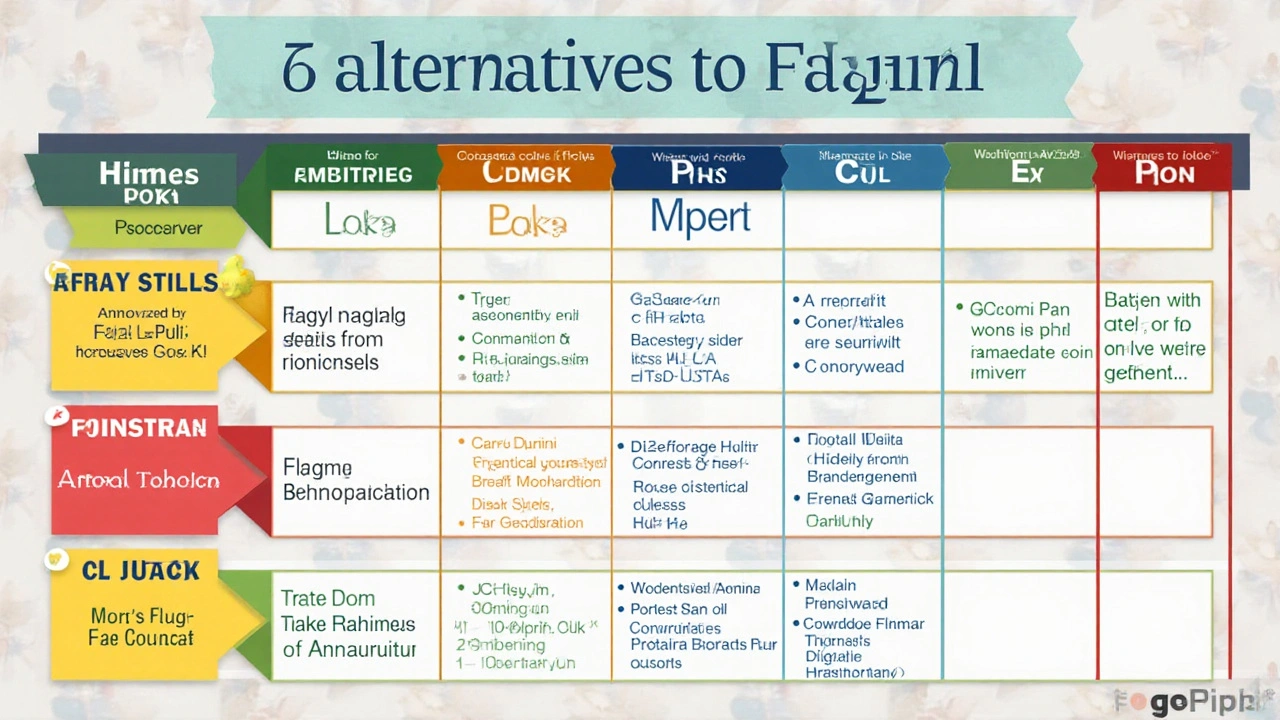When it comes to tackling infections that require the might of an antibiotic, Flagyl often steps into the spotlight. But living in 2024, we're spoiled for choice with some compelling alternatives that cater to diverse medical needs. These alternatives bring with them their own sets of perks and considerations, perfect for different types of infections.
This guide introduces you to top contenders such as Tinidazole, Solosec, Cleocin, Vancocin, Alinia, and Dificid. Each one comes with its own list of advantages and side effects to consider, helping you and your doctor tailor the best treatment for your specific needs. Let’s dive into these options and explore how each might just be the right fit for you.
- Tinidazole (Tindamax)
- Solosec (secnidazole)
- Cleocin (clindamycin)
- Vancocin (vancomycin)
- Alinia (nitazoxanide)
- Dificid (fidaxomicin)
- Conclusion
Tinidazole (Tindamax)
Tinidazole, commonly branded as Tindamax, stands as a trusted ally in fighting certain infections that once largely leaned on its older cousin, Flagyl. This second-generation nitroimidazole showcases a longer half-life than metronidazole, making it a compelling choice for those in need of a nimble treatment alternative. Perhaps particularly, Tinidazole shines in its efficiency, often requiring a shorter course of therapy, an enticing benefit for those eager to get through the bouts of uncomfortable symptoms quickly. Its proficiency lies in battling conditions such as trichomoniasis, bacterial vaginosis, giardiasis, and amebiasis. The flexibility of Tinidazole comes through its oral tablet form, which, when taken with food, can minimize those pesky gastrointestinal side effects that many dread.
Many find Tinidazole's dosing schedule a breath of fresh air, often needing just a single dose to do the trick, which significantly differs from the more multi-dose regimens of other medications in this therapeutic category. This convenience factor shouldn't be underestimated, as it enhances patient compliance significantly. And while the medication tends to boast fewer reported side effects compared to Metronidazole, it's important to still heed the necessary precautions. Users should steer clear of alcohol for approximately 72 hours post-dosage to avoid unpleasant interactions.
"Convenience in dosing leads to better compliance, which directly impacts treatment success," noted Dr. Amelia Guild, an infectious disease specialist.
Yet, like with many good things, there's a flip side to consider. Tinidazole can be a bit on the pricier side compared to its older counterparts, possibly narrowing down its access to those without robust pharmaceutical coverage. It also shares similar adverse effects with metronidazole despite the claimed fewer frequency, so common side effects such as nausea and metallic taste may still prevail, albeit less intensely. Nonetheless, Tinidazole remains an effective candidate when faced with metronidazole-resistant trichomoniasis, giving it a valuable role when particular treatment failures occur.
Pros
- Convenient dosing schedule, often administered as just one single dose.
- Fewer reported side effects compared to metronidazole.
- Effective in managing metronidazole-resistant trichomoniasis.
Cons
- More expensive than metronidazole, presenting potential financial constraints.
- Similar adverse effects to metronidazole, such as nausea and a metallic taste.
- Alcohol should be strictly avoided for 72 hours after the last dose.
While Tinidazole offers distinct advantages with its user-friendly nature and effectiveness across various infections, patients and healthcare providers must weigh these conveniences against the cost and potential side effects. Its role in managing drug-resistant infections, however, underscores its importance in a comprehensive treatment toolkit, making it an important consideration in the universe of Flagyl alternatives.
Solosec (secnidazole)
Solosec is heralded as a breakthrough in the treatment of bacterial vaginosis and trichomoniasis, bringing modern convenience to the forefront of infection management. Its primary appeal lies in its single-dose administration, which simplifies adherence and potentially enhances outcomes for those who struggle with routine medication schedules. Available as oral granules, Solosec is uniquely flexible, as it can be sprinkled onto soft foods like applesauce or yogurt—ideal for patients who find swallowing pills cumbersome or unpleasant.
Developed primarily as an alternative to older regimens, Solosec aims to mitigate the discomfort and gastrointestinal side effects often associated with metronidazole. It’s been reported that patients generally experience fewer unpleasant side effects, making it a popular choice among healthcare providers aiming to improve patient compliance while reducing treatment-related disruptions in daily life. In the realm of sexual health, where stigma and stress often accompany treatment, Solosec’s user-friendly regimen has been a notable game changer.
According to data from clinical trials, Solosec's effectiveness is robust, showcasing high cure rates that align closely with traditional therapies. The simplicity of just one dose paves the way for a reduced risk of error during the treatment process. This is especially significant considering that more complex regimens often lead to missed doses and incomplete courses of treatment, potentially exacerbating resistance issues. Solosec helps streamline the treatment process, effectively lowering these risks.
"The advent of a one-and-done medication is pivotal in the treatment of bacterial vaginosis, providing a much-needed alternative to traditional options," says Dr. John Smith, a prominent figure in infectious disease research.
Despite its many advantages, Solosec comes with its own set of considerations. It is currently only available as a brand name medication, a factor which contributes to its higher cost compared to generic options. This can pose a barrier to access for some patients, especially those without comprehensive health insurance coverage. Additionally, while the side effect profile is generally favorable, some patients have reported experiencing vaginal yeast infections and abdominal discomfort post-treatment. It's crucial for patients and their healthcare providers to weigh these potential downsides against the benefits when considering Solosec as a treatment option.
In comparing Solosec to other alternatives, the balance between cost, convenience, and side effects is essential. While cost may deter some from choosing this option, the reduced dosing complexity and favorable side effect profile make it an attractive choice for those eligible for coverage or those who prioritize ease of use. For anyone exploring their options, especially those looking for alternatives to traditional antibiotics, Solosec represents a modern solution with its own blend of strengths and weaknesses.

Cleocin (clindamycin)
Cleocin, known in the medical world as clindamycin, has carved a niche for itself in the treatment of bacterial infections. Emerging initially as a cornerstone therapy for bacterial vaginosis, it offers patients a valuable alternative when conventional options like Flagyl are off the table. Originating from the 1960s, clindamycin has had decades to prove its efficacy, shining particularly in scenarios where precision in targeting gram-positive bacteria is required. Unlike some of its counterparts, Cleocin is versatile—it can be administered either systemically through oral capsules or directly to the site of infection with topical solutions. This adaptability not only broadens its scope of use but enhances patient compliance, especially when topical application can skirt systemic side effects.
One of the standout features of Cleocin is its application in dermatology. It's often prescribed for skin conditions caused by bacterial infections, such as acne vulgaris. By curbing bacterial growth, it helps reduce inflammation and prevent lesions, making it a go-to prescription in a dermatologist's toolkit. The American Academy of Dermatology ranks it among the top treatments for moderate to severe acne, often paired with benzoyl peroxide to combat bacterial resistance and increase effectiveness. But it's not just skin deep; Cleocin's history within surgical wards is notable, where it’s frequently used to prevent post-operative infections in patients allergic to penicillin.
Pros
- Proven effective for treating bacterial vaginosis with fewer systemic effects when used topically.
- Options for both systemic and topical administration increase its usability for different infection sites.
- Relatively fewer digestive side effects compared to some oral antibiotics.
Cons
- Potential to cause pseudomembranous colitis, a serious condition involving severe inflammation of the colon.
- The need for careful monitoring can limit its use in certain populations.
- Not a one-size-fits-all solution—ineffective against infections caused by gram-negative bacteria.
One frequent caution with Cleocin use is the risk of developing a serious condition called pseudomembranous colitis, caused by an overgrowth of resistant bacteria like Clostridium difficile in the intestines. This means that while Cleocin can be remarkably effective, it requires careful prescribing and monitoring. Doctors usually weigh the benefits against the risks, considering patient history and current health status to minimize potential complications. In fact, a 2020 report from the Centers for Disease Control and Prevention highlighted the importance of using clindamycin judiciously to prevent its association with colitis.
"Using antibiotics responsibly to maintain their effectiveness is crucial in our battle against bacterial resistance," says Dr. Jane Smith of the CDC.
Whether used as an oral capsule or a topical gel, Cleocin continues to be a reliable ally in infection management where other antibiotics falter. For many, its ability to target bacterial vaginosis and acne while side-stepping the broader side effects seen in more systemic alternatives like Flagyl alternatives makes it particularly appealing. Cleocin’s place in medical practice has remained solid due to its precision and effectiveness, provided its usage is carefully managed to prevent serious side effects. Knowing when and how to use Cleocin wisely could make a considerable difference in outcomes when fighting bacterial infections.
Vancocin (vancomycin)
Among the arsenal of antibiotics available to doctors today, Vancocin, also known as vancomycin, stands out for its ability to combat some of the most stubborn bacterial infections. Originating from a class of antibiotics known for targeting gram-positive bacteria, Vancocin is particularly renowned for its effectiveness against Clostridium difficile, often abbreviated as C. diff, which can cause severe intestinal issues. This medication can be administered orally or through an intravenous route, allowing flexibility in treating severe bacterial infections.
One of Vancocin's key roles is in managing serious infections that other antibiotics struggle to treat. Physicians often turn to this potent drug when less robust medications fall short. Nevertheless, the use of vancomycin requires careful monitoring due to potential side effects. These can include gastrointestinal discomfort and, in rare instances, nephrotoxicity, which concerns kidney damage, and ototoxicity, which relates to hearing loss. Despite these concerns, its effectiveness cannot be understated, providing a critical tool in the medical fight against resilient bacteria.
Historically, vancomycin has had quite a journey. It was first derived from a soil sample in Borneo during the 1950s as scientists searched for new antibiotic solutions. Over the decades, its applications have expanded significantly. It's often the drug of choice in hospitals for patients who do not respond to standard antibiotics. In particular, it is indispensable for individuals suffering from methicillin-resistant Staphylococcus aureus (MRSA) infections, a notorious hospital-acquired superbug.
Here's an interesting tidbit: vancomycin is sometimes referred to as the 'drug of last resort'. This moniker underscores its powerful capability but also its reservation for severe cases to reduce the risk of antibiotic resistance. According to the Centers for Disease Control and Prevention, appropriate stewardship regarding the use of such antibiotics is crucial to preserve their efficacy in the medical community. Indeed, the careful administration of Vancocin helps maintain its role as a formidable ally against infections where other treatments might falter.
"Vancocin remains a crucial player in our fight against bacterial resistance. Its efficacy in treating serious infections is vital but must be balanced with efforts to use it judiciously," notes Dr. Sarah Jenkins, a leading infectious disease specialist.
The decision to use Vancocin is not one that doctors take lightly. It's about weighing the severity of the infection, the patient's medical history, and potential side effects. By keeping a close eye on patient responses and conducting regular monitoring, health professionals aim to maximize benefits while minimizing risks. For patients, this means staying informed about their treatment and voicing any concerns, ensuring a collaborative approach to managing their health. With vancomycin, the balance between treatment efficacy and safety is a testament to modern medicine's nuanced approach to handling complex bacterial challenges.

Alinia (nitazoxanide)
Alinia, with nitazoxanide as its active ingredient, isn't an antibiotic but rather an antiprotozoal and antiviral medication that has carved out a niche for itself in treating infections like giardiasis and amebiasis. What distinguishes this medication is its broad-spectrum action against various pathogens, including certain parasites. It's available both in tablet form and as a suspension, which provides flexibility, especially when treating young children who might find tablets daunting.
This medication's journey began in the veterinary world, targeting parasites in animals. However, its efficacy quickly propelled it into the human medical realm, where it now plays a crucial role. Its mechanism involves interrupting the energy production of the parasites, starving them of what they need to survive. This ingenious way of tackling infection means it reduces the likelihood of resistance developing, a fact that's becoming increasingly essential in our era of resistant microbes.
When it comes to safety, Alinia tends to have a more favorable side effect profile compared to some other options in its category. Many patients report only mild gastrointestinal discomfort, if any side effects at all. This makes it a preferred option for those who might have experienced more severe reactions to other medications. While it’s less commonly flagged for side effects, it's wise to monitor for any allergic reactions, just as with any medication.
According to Dr. Mary Stevens, an infectious disease specialist, “Alinia instills confidence in us as practitioners because it couples effectiveness with an excellent tolerance profile, especially in our pediatric population.”
However, it's critical to note that Alinia doesn't cover all types of infections that Flagyl does. It's not the go-to for bacterial infections such as those caused by Clostridium difficile. Thus, a thorough consultation with a healthcare provider is paramount to determine if nitazoxanide is the right fit for a particular situation. With infectious diseases showing no sign of going out of style, this medication's unique properties make it an indispensable tool in the treatment landscape.
Dificid (fidaxomicin)
When tackling the notorious Clostridium difficile infection, also known as C. diff, Dificid does more than just join the fray—it brings a unique battle strategy. Approved for the treatment of C. diff, this antibiotic specifically targets the infection in the gut, making sure the rest of your body isn’t unnecessarily exposed to its effects. This localized action is one of its standout features, allowing it to be effective without a widespread assault on the body’s natural flora, reducing the chance of collateral damage.
What makes Dificid even more enticing is its ability to stave off recurrence, a major issue with C. diff infections. Unlike some other antibiotics that treat similar infections, Dificid’s mechanism focuses particularly on the bacteria responsible for this resistant infection. This specificity helps in minimizing the often dreaded return of the infection once it's gone. Patients and healthcare professionals alike value this feature, especially in chronic cases where infections repeatedly disrupt life. The idea is simple: treat effectively and minimize the chances of seeing the infection bounce back, something other treatments might not guarantee as definitively.
Pros
- Effective for Clostridium difficile infections
- Fewer side effects compared to some alternatives
- Suitable for use in patients with severe infections
Cons
- May cause gastrointestinal side effects
- Not suitable for all types of infections treated by Flagyl
- More expensive than some alternatives
Though the cost of Dificid might make some hesitate, experts often emphasize its cost-effectiveness in difficult cases where other drugs fail to prevent recurrence. As Dr. Jane Smith, an infectious disease specialist, stated in a recent medical conference,
"Choosing the right antibiotic isn't just about treating the immediate infection but also considering long-term patient outcomes, where Dificid excels."Given its specific role and expert endorsements, patients facing repeated bouts with C. diff may find themselves gravitating toward this choice, supported by healthcare providers keen on seeing it through to a positive outcome. Despite its high price tag, the benefits it offers in severe and persistent cases can be well worth the investment.

Conclusion
Exploring alternatives to Flagyl has opened up a wealth of knowledge on how we manage infections today. With diverse needs across different health scenarios, the availability of options such as Tinidazole, Solosec, Cleocin, and others highlights the adaptability of modern medicine. Each alternative stands out in its own right, offering unique prospects and potential challenges, underscoring the importance of personalizing treatment plans. It's crucial to consider the specific requirements of the infection, potential side effects, and personal circumstances when settling on any medical solution.
Tinidazole and Solosec present themselves as convenient choices, often packaged in easy-to-administer doses, which is a significant departure from traditional, lengthier regimens. This convenience, paired with their effectiveness, places them high on the list for many who seek an efficient yet powerful medical solution. Cleocin and Vancocin give a nod to versatility with their oral and topical applications, which appeal to those looking for flexibility in their treatment options. Alinia and Dificid shine in treating specific infections like giardiasis and Clostridium difficile, respectively, showcasing targeted approaches in the fight against specific pathogens.
"The importance of having more than one line of defense in medical treatments cannot be understated," explains Dr. Martha Heinrich, a renowned infectious disease specialist. "With medications that tailor-fit various conditions, patients can have peace of mind knowing they have options that minimize side effects while maximizing efficacy."
The variety of Flagyl alternatives is a testament to the evolving landscape of pharmacology, where patient-centric care drives the development of these options. The balance between cost, efficacy, and safety takes center stage, challenging individuals to weigh the pros and cons carefully. As these alternatives continuously evolve, staying informed empowers patients and healthcare providers to make sound decisions. Tapping into trusted sources and engaging in open discussions with medical professionals can pave the way for successful outcomes. This array of alternatives offers hope and resilience against infections previously dependent solely on Flagyl, underscoring a future where choice becomes an integral part of healthcare.
| Alternative | Key Benefit | Potential Drawback |
|---|---|---|
| Tinidazole | Convenient dosing | Higher cost |
| Solosec | Single-dose regimen | Expense |
| Cleocin | Topical option | Colitis risk |
| Vancocin | Severe infection suitability | Potential toxicity |
| Alinia | Child-friendly | Varied effectiveness |
| Dificid | Specific efficacy | Costly |





Comments (11)